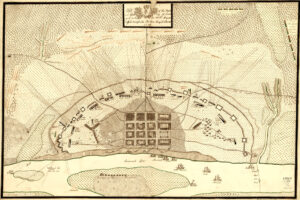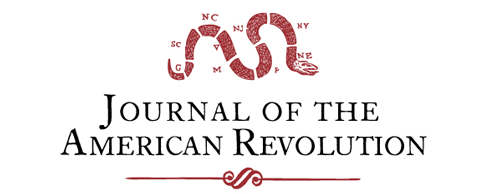Georgia’s legendary John Twiggs had a distinguished public career during and after the American Revolution, but he left almost no other information about himself, as reflected in the extremely concise and brief text on his tombstone and obituary. The family descends from the Twiggs family of Devonshire, England, reportedly including Thomas Twiggs (died 1614) of Jamestown, Virginia.[1] A biographical sketch published in 1849, apparently from information provided by John’s sons, gives Maryland as his place of birth and a date of June 5, 1750, the same date that is on his tombstone.[2] His parents, George Twiggs and his second wife, Elizabeth Bryan, were reportedly poor and died after arriving in Georgia in 1751. He then lived with David Emanuel Sr.
Twiggs’ biographer described him as five feet ten inches tall, stoutly made, well proportioned, with gray eyes and a florid complexion. He had a limited education and became a carpenter who built a mill in what became Richmond County, Georgia, following his marriage, in or after 1769, to Ruth Emanuel (died 1827), the sister of a later governor of Georgia, David Emanuel Jr.[3]
The earliest reference now found to any Twiggs in Georgia is to John witnessing a deed in 1772.[4] A copy of now-lost public records, certified in 1897, shows him commissioned as a first lieutenant in a newly formed regiment of colonial militia in St. Paul Parish (used as the boundaries of original Richmond County in 1777), Georgia, on June 10, 1772. That same document also shows his promotion to captain in February 1774. He likely served in the disastrous defeat of the colony’s notoriously poorly trained and equipped militia by Creek warriors on the frontier in the summer of 1773.[5]
Information on how Twiggs came to join the American Revolution has not survived. He was a tradesman, the class from whom Georgia Royal Governor Sir James Wright and Loyalist Elizabeth Liechtenstein remarked that the rebels came. They regarded such middle-class men as, with milk, the scum who rose to the top.[6]
In 1775, Twiggs was a private in Capt. John Lamar’s company appointed by the Georgia Revolutionary Council of Safety.[7] He subsequently raised a militia company at his own expense and served under Col. Samuel Jack in destroying two Cherokee villages in the multi-state campaign against that tribe in the summer of 1776.[8]
Twiggs moved to St. George Parish, the political boundaries of which, after February 1777, became Burke County, Georgia. The people of the new county had conflicting politics. Col. John Thomas, the county’s militia regiment commander, had held two colonial commissions. He resigned both when he joined the rebellion following the arrival of news of the outbreak of war in April 1775.[9]
As the political and military situation for the patriots deteriorated, Thomas changed his loyalty. He suffered arrest for attempting to join a group of South Carolina Loyalists or Tories (Americans who remained loyal to the King) known as “Schoffelites.” Led by notorious chicken thief Joseph Coffiel, those King’s men and/or bandits successfully passed through Georgia in the summer of 1778 en route to British East Florida, despite the best efforts of the state’s declining military establishment to intercept them. By January 1779, Francis Pugh was elected as a colonel in the Burke County regiment, with John Twiggs as his major.[10]
In the interim, British forces captured Savannah, Georgia’s capital, on December 29, 1778. Pugh tried to rally his Patriot militia at what was known as the New Court House and the Burke County jail on the site of the modern city of Waynesboro on January 9, 1779. He sent a plea for help to the remains of the state government that met in Augusta. The Lower Richmond County Militia Battalion under Col. Benjamin Few, Lt. Col. James Ingram, and Maj. William Few arrived at the camp. After detachments were sent out, they numbered some 120 men.
On the morning of January 26, 1779, Loyalist provincials known as the King’s Rangers under Lt. Col. Thomas Brown, and the reconstituted St. George Parish colonial militia under Col. John Thomas, some 230 men in total, attacked the Patriots at Burke County jail. Soon, only sixty of Few’s and Pugh’s men remained holed up in the log buildings. The King’s men finally withdrew, but the Patriots also quickly left. Aside from prisoners taken, the Patriot militia had five men killed and nine wounded, while the King’s men had seven killed and fifteen wounded. Brown and Thomas were both wounded, the latter shot in the lip.[11]
No accounts survive of what John Twiggs did in the Battle of Burke County Jail. Georgia’s temporary ad hoc state government commissioned him as colonel of the militia on June 23, 1779, to date from the day of that battle. Perhaps this promotion was a reflection of his performance that day, but it may also have been the result of his subsequent actions in keeping alive the Patriot cause in Burke County that rapidly became a no man’s land embroiled in a civil war. British Lt. John Wilson wrote that some Georgians were “following The King’s troops, others with the Rebels, and both revengefully destroying the property of the other.”[12]
American forces in South Carolina aided Twiggs and his men, while the British in Savannah provided for the Loyalists who followed Thomas. The King’s forces had occupied Augusta, Georgia’s second-largest settlement and the gateway to the frontier, before withdrawing to the coast on February 14, 1779, the same day that Carolina Loyalists met defeat at the nearby Battle of Kettle Creek, Georgia. At almost that exact moment, John Twiggs and his command, traveling with troops under Col. John McIntosh of Georgia and Col. Leroy Hammond of South Carolina, passed in front of the retreating redcoats and captured thirty men at the enemy outpost at Herbert’s plantation.[13]
Twiggs and his men then traveled in the company of and under the command of Lt. Col. Eli Kershaw of South Carolina, a total of 200 men. At Shell Bluff Community, near Augusta, on the night of March 31, 1779, 200 mounted Loyalists under Maj. John Spurgeon of the South Carolina Royalists Regiment and Maj. Henry Sharp of Thomas’ reconstructed colonial Georgia militia attacked them. Spurgeon had led the survivors who escaped the Loyalist defeat at the battle of Kettle Creek, and Sharp was fighting a successful guerrilla war against the Patriots.
A desperate battle ensued in the dark, but when it ended, the Patriots had suffered only three wounded men, one mortally. In comparison, the retreating Loyalists may have lost as many as twenty men killed and mortally wounded, including both Sharp and Spurgeon. Joshua Inman, a captain under Twiggs, received credit for the deaths of the Tory majors.[14]
John Twiggs became proactive in the months that followed. On June 26, 1779, while accompanying Col. John Baker of Georgia on a raid against Savannah, Twiggs and thirty-two of his men camped at James Butler’s plantation near the town. Forty-two British grenadiers under went out of the British lines to attack the raiders but were ambushed and surrounded by Twiggs and his men behind the plantation’s rice dams. The captain leading them was killed, and all but two of his guides were killed or captured.
Twiggs’ Patriot militiamen now turned guerrilla. They rescued several Continental officers being held by the British as prisoners on parole. On August 24, Twiggs and Inman, while accompanying Continental horsemen, led their men against the notorious Loyalist bandit Daniel McGirth based on the widow Lockhart’s plantation in the Loyalist community of Big Buckhead Creek in Burke County. Seven of the thirty to forty Loyalists engaged were killed. McGirth, who escaped, received wounds so bad that he was wrongly reported to have died. Twiggs kept spies and scouts in this conflict zone between Patriot-controlled Augusta and the British Savannah.[15]
Under their colonel, these Burke County Patriot militiamen also served in larger campaigns. They may have been among the Americans defeated by the British at Briar Creek on March 3, 1779. In the latter, on some of the men among the dead and captured, the British discovered signed oaths of allegiance only recently made to the King’s officers.

When American and French forces united to lay siege to Savannah in the autumn of 1779, Twiggs’ regiment swelled to more than 100; many of his neighbors now wanted to be seen on the winning side, as the war in Georgia appeared to be soon over. Lack of supplies, bad weather, and the increasing strength of British positions encouraged desertions, however. By October 11, Twiggs’ regiment had forty-eight men absent without permission, including two captains and a lieutenant. He and what remained of his regiment participated in the disastrous attack on the British lines on October 9 and withdrew with the rest of the Allied forces shortly afterward.[16]
During the British invasion, what remained of Georgia’s state government was in turmoil as different factions claimed to be the legitimate legislative authority. In the spring and summer of 1779, an ad hoc government formed an executive council in Augusta that gave Twiggs the rank of colonel and Col. John Dooly overall command of the militia. Twiggs, however, stayed clear of the council and Dooly.[17]
An opposition faction won elections in what remained of the state and claimed sovereignty. Twiggs became a member of the House of Assembly and the ruling executive council. He would, however, later disavow in writing the claims that the council asked Congress for the removal of Lachlan McIntosh as commander of the Georgia Continental forces in the winter of 1779-1780 or had any complaints against McIntosh, contrary to the statements made by then-Governor George Walton.[18]
In March 1780, while British forces successfully laid siege to Charlestown, South Carolina, Twiggs and what remained of his militia joined Col. Andrew Pickens of South Carolina and his regiment in a diversionary raid into the areas around Savannah. They successfully skirmished with Daniel McGirth’s Loyalist bandits at Midway and defeated a company of armed slaves on Royal Gov. James Wright’s plantation.
Sixty-six British regulars set out to defeat these Americans as they camped at Briton Dawson’s farm near Midway on April 4. Twiggs’ Capt. Joshua Inman lured the redcoats into an ambush that Twiggs sprung, resulting in Conklin’s death and his troops’ defeat. Pickens and Twiggs also destroyed hundreds of barrels of rice before returning to Augusta.[19]
Charlestown fell to the British on May 12, and soon after, most of the remaining American forces surrendered in exchange for paroles that allowed them to remain at their homes. For Twiggs, the war hardly changed. He and the men who still followed him traveled through the Carolinas to Virginia before returning to South Carolina in the company of Gen. Horatio Gates and his army. The Georgians likely suffered in the terrible march that Gates’ army made in a desperate attempt to reverse American fortunes in the South. Twiggs was severely wounded by a saber and left for dead at the subsequent Battle of Camden on August 16, 1780, another major disaster in a formal battle for the Patriot cause.[20]
The following November, South Carolina partisan Thomas Sumter assembled 1,000 men, including Georgians under John Twiggs, William Candler, Elijah Clark, and James Jackson, to succeed where Gates had failed. The Burke Countians under Twiggs supposedly joined Sumter in time to participate in the victory at Fishdam Ford, South Carolina, on November 9.
Sumter learned of the approach of British and loyalist infantry and cavalry under the notorious Banastre Tarleton. With only an advance force of some 260 men, Tarleton attacked Sumter’s position at William Blackstock’s plantation on November 20. In the complex battle that followed, the King’s troops took severe blows on all flanks, but Sumter fell from a near-fatal wound. The partisan leader turned his command over to Twiggs, his senior-ranking officer present. Although the fighting continued for three more hours, the victory had been won, and the Georgians secured the prisoners and plunder. Twiggs treated the wounded of both sides, an action that earned compliments from Tarleton.
Without Sumter’s force of personality to lead them, these independent fighters could not hold together, especially before the approaching full force of Tarleton’s command. Twiggs had to disband this ad hoc army, and some of these men returned to their homes for the rest of the war. Twiggs’ men, including Joshua Inman and later governor James Jackson, served with distinction at the subsequent battle of Cowpens that destroyed Tarleton’s command.[21]
By late December 1780, Twiggs and his guerrillas had returned to raid the area around Augusta. The British had made Georgia the only American state ever reduced to colony status, and the restored colonial assembly passed an act labeling Twiggs a public enemy.[22]
Twiggs came to Augusta under a flag of truce to retrieve his family, but after leaving with them, his party rode into an ambush. A boy named Watson, who held the white flag, was fatally shot. Twiggs narrowly avoided being killed himself and had to flee, leaving his family to the mercy of attackers who plundered them and then let them go. He and his partisans again narrowly avoided capture when they were attacked at a house at Beach Island, South Carolina, near Augusta, by Thomas Brown’s King’s Rangers.[23]
By the following spring, Georgia’s refugee congressional delegation had appointed Dr. Nathan Brownson as brigadier general of the state’s military. Maj. Gen. Nathanael Greene, commander in the South, however, doubted that the state’s militia would agree to this political appointment of a relative nobody. A compromise made Brownson the governor and promoted Twiggs to brigadier general and state militia commander.[24]
In the meantime, the new brigadier had joined Henry Lee, Andrew Pickens, and Elijah Clark in reducing the British outposts in and around Augusta. Twiggs participated in the capture of the first of these forts to fall at Silver Bluff, and he served through to the final surrender, that of Fort Cornwallis at Augusta, with its garrison of Thomas Brown and his Loyalists, Creek warriors, and King’s Rangers, on June 5, 1781.[25]
Twiggs and his men fought to confine the British within their outposts near Savannah. Each side claimed a series of skirmishes on the Ogeechee River on November 2, 1781 as a significant victory. In December, he and his men defeated Cherokees and their white trader allies at the forks of the Ohoopee River. Gen. Anthony Wayne took command of the American military efforts in Georgia in January 1782 and accepted Savannah’s surrender on July 11, 1782.[26]
The end of the war created new complications for Twiggs and for Georgia. He received numerous public service positions, including various legislative seats, and as a county commissioner at different times in Burke and Richmond counties, respectively. Other positions where Twiggs served included commissioner to treat with the Indians in 1783, 1785, and 1803; commissioner to run Indian boundaries in 1791 and 1797; and presidential elector in 1802, as well as commissioner for confiscating Loyalist property and as an escort to George Washington during the former president’s tour of Georgia in 1791.
Twiggs actively promoted education as a trustee of the Richmond County Academy and the fledgling Franklin College, the University of Georgia, the first state-chartered school of higher education. He took a special interest in the University of Georgia, where he helped lay out and donate money for a chapel.[27]
The most controversial service by the general came in 1794 and 1795 when a bribed governor and legislature sold the state’s claims to today’s Alabama and Mississippi in the infamous Yazoo Land Fraud. Twiggs stood against the sale and fought to have it repealed. He helped to form the Union Company of Georgia and unsuccessfully bid on these same lands, but that effort may have been only a ruse to delay the sale of the lands with a phony bid. Twiggs felt disgusted that the lands were not granted to veterans for their services. He refused, however, to use the militia to overthrow the government. When the governor’s term of office ended abruptly in 1795, Twiggs could have briefly replaced him as the state’s highest-ranked military officer. He declined requests to do that or to use force to prevent the legislature from passing the Yazoo Bill.[28]
Twiggs continued as a soldier. On September 8, 1791, the state of Georgia promoted him to major general of the militia. In 1793, he formed 600 men to strike back against Creek Indian raids. They crossed the Oconee River and established a fort, but withdrew due to insufficient supplies. Critics claimed that his command attacked at least some peaceful Indians and unaffected villages. That same year, when John Clark did the same with 700 men, General Twiggs volunteered as a way to encourage the troops.[29]
In 1794, when Maj. Gen. Elijah Clark (John Clark’s father) tried to end the Creek raids by seizing Indian lands on the west side of the Oconee River, Twiggs had the thankless job of mobilizing the state militia against him. Fortunately, Clark would not fight against his old comrades and abandoned his settlements. Twiggs took an active part in preparing Georgia for war with Great Britain in 1807 and 1812, as well as against an alleged plot to start a slave revolt in 1810.[30]
John and Ruth Emanuel Twiggs lived to enjoy the benefits of their years of sacrifice during the Revolution. The state of Georgia did not grant him the special considerations given to other war leaders, but he did acquire vast amounts of land on both sides of the Savannah River, partly from purchasing confiscated Loyalist estates. Twiggs centered his extensive operations around his Good Hope plantation. His tobacco operations included warehouses and wharves in Augusta and Savannah. The couple raised five sons and one daughter (George, David E., Levi, Abraham, Acy, and Sarah) through whom a military dynasty would begin, including Confederate Gen. David Emanuel Twiggs, which continues to the present.[31]
John Twiggs also became well known for his hospitality, especially for entertaining old comrades from the war in his last years. On March 29, 1816, he died in Richmond County, near where his military career began, at that time the oldest major general still serving in the United States. Twiggs is buried in the family cemetery at his former Good Hope plantation. Despite his modest request to the contrary, his grave has been marked. Georgia named its thirty-seventh county for him in 1809. He was the only Georgia Revolutionary hero who lived to be personally so honored.
Georgia historian and geographer George White wrote that John Twiggs’s public career would have filled a volume, but even with the most extensive research, the character of this Georgia partisan leader would likely remain a mystery. No one gave the general a nickname like the “Gamecock” or, even more deservingly, “Old Faithful.” He inspired men to follow him on dangerous missions, including the recklessly heroic Joshua Inman, but he seems to have acted responsibly with their lives. Although some other Georgia partisan leaders at that time gained reputations as murderers, Twiggs is remembered for his mercy. He even supposedly saved one Loyalist from being executed by the notorious Patrick Carr, who was credited otherwise with having murdered more than 100 men.[32]
In the complex times after the war, Twiggs sailed through major crises with a singleness of purpose and integrity that rose above the partnership of the times. Rewards came to him for his service despite any known acts of personal ambition. He became a hero of the American Revolution and for his actions after the war, but always for what he did, not for who he might have claimed to be or what he might have deserved.
[1] Twiggs Family Genealogy, ms1052, Hargrett Rare Books and Manuscripts Library, University of Georgia Libraries. Athens; Twiggs Family Papers, Southern Historical Collection, Wilson Library. University of North Carolina at Chapel Hill.
[2] A genealogy without documentation has him as born December 12, 1750; perhaps this is the date of his baptism.
[3] George White, Statistics of the State of Georgia Including an Account of its Natural, Civil, and Ecclesiastical History with a Particular Description of Each County, Notices of the Manners and Customs of its Aboriginal Tribes and a Correct Map of the State (Savannah, GA, 1849), 564-569; Mary Bondurant Warren and Jack Moreland Jones, comps., Georgia Governor and Council Journals 1753-1760 (Athens, GA: Heritage Papers, 1991), 84; Colonial Government, Estate Records, RG 49-1-1, Georgia Archives Georgia Virtual Vault, vault.georgiaarchives.org/cdm/compoundobject/collection/corp/id/2342/rec/1.
[4] Colonial Conveyance Book X2 (1772-1774), 871-872, Record Group 49-1-3, microfilm drawer 40 roll 42, Georgia Archives, Morrow.
[5] John Twiggs, Name File, Georgia Archives, Morrow; Edward J. Cashin and Heard Robertson, Augusta and the American Revolution: Events in the Georgia Back Country, 1773-1783 (Darien, GA: Ashantilly Press, 1975), 3-7.
[6] Rick Atkinson, The British Are Coming: The War for America, Lexington to Princeton, 1775-1777 (New York: Holt, 2019) 178; Elizabeth Lichtenstein Johnston, Recollections of a Georgia Loyalist (New York: M. F. Mansfield, 1901), 45.
[7] Roster of Capt. John Lamar’s Company, August 30-September 19, 1775, Telamon Cuyler Collection, Mss1177, Series 5, folder 5, Hargrett Rare Book and Manuscript Library, University of Georgia Libraries, Athens.
[8] Hugh McCall, History of Georgia: Containing Brief Sketches of the Most Remarkable Events Up to the Present Day, 2 vols. (Savannah, GA: Seymour & Williams, 1811 and 1816), 2: 82-83, 87. Also see Nadia Dean, A Demand for Blood (Cherokee, NC: Valley River Press, 2012).
[9] Cashin and Robertson, Augusta and the American Revolution, 23-24; Robert S. Davis Georgians in the Revolution (Greenville, SC: Southern Historical Press, 1986), 179-180, 185-186; Joseph W. Barnwell, “Barnard Elliott’s Recruiting Journal,” South Carolina Historical Magazine 17 (July 1916): 97. During the American Revolution, John Thomas was captured by the Patriots and held in dismal conditions in Charleston, South Carolina. He was banished from Georgia and may have been a Virginia native with a wife and four children in East Florida in 1783. He was allowed to return to Georgia in 1788. Davis, Georgians in the American Revolution, 103-104, 159; Lawrence H. Feldman, The Last Days of British Saint Augustine 1784-1785: A Spanish Census of the English Colony of East Florida (Baltimore, MD: Clearfield, 1998), 32.
[10] Gordon B. Smith, History of the Georgia Militia, 1783-1861, 4 vols. (Milledgeville, GA: Boyd Publishing, 2000), 1: 56.
[11] Davis, Georgians in the American Revolution, 97-107.
[12] John Wilson, Encounters on a March Through Georgia in 1779, ed. by Robert S. Davis (Sylvania, GA: Partridge Pond Press, 1986), 43.
[13] Gordon B. Smith, Morningstars of Liberty: The Revolutionary War in Georgia, 1775-1783, 2 vols. (Milledgeville, GA, 2006), 1:144-145; “Extract of a Letter from Adams Ferry, February 20,” South Carolina and American General Gazette (Charleston), March 4, 1779; “From the London Gazette,” Gazetteer and New Daily Advertiser (London), April 21, 1779; Davis, Georgians in the Revolution, 23 n. 35, 147-148.
[14] Davis, Georgians in the American Revolution, 110-111.
[15] John Twiggs to Benjamin Lincoln, August 7, 1779, Simon Gratz Autograph Collection [0250B], box 279, Historical Society of Pennsylvania, Philadelphia, 157; Smith, Morningstars of Liberty, 1: 157.
[16] Robert S. Davis, “The Invisible Soldiers: The Georgia Militia and the Siege of Savannah.” Atlanta Historical Journal 25 (Winter 1991): 23-66.
[17] Allen D. Candler, The Revolutionary Records of Georgia (Atlanta, GA: Franklin-Turner, 1908), 2: 138; “Col. Dooly’s Campaign of 1779,” Huntington Library Quarterly 46 (Winter 1984): 65-71.
[18] Edward J. Cashin, “George Walton and the Forged Letter.” Georgia Historical Quarterly
62 (Summer 1978): 133-145. Walton had previously supported the other faction. A signer of the Declaration of Independence, after having McIntosh removed, he returned to the Continental Congress.
[19] Smith, Morningstars of Liberty, 1:157-159, 182-183.
[20] Ibid., 1:209.
[21] Ibid., 1:222-224; Robert D. Bass, Gamecock: The Life and Campaigns of General Thomas Sumter (New York: Holt, 1961), 102, 104, 108-109; James Jackson “The Papers of James Jackson, 1781-1798,” ed. Lilla M. Hawes, Georgia Historical Society Collections (Savannah, GA: Georgia Historical Society, 1955), 11: 17-18.
[22] George White, Historical Collections of the State of Georgia: Containing the Most Interesting Facts, Traditions, Biographical Sketches, Anecdotes, Etc., Relating to Its History and Antiquities, from Its First Settlement to the Present Time. Comp. from Original Records and Official Documents (New York: Pudney & Russell, 1854), 103; Kenneth Coleman, “Restored Colonial Georgia, 1779-1782,” Georgia Historical Quarterly 40 (March 1956): 1-20.
[23] Smith, History of the Georgia Militia, 1783-1861, 1: 348; White, Statistics of the State of Georgia, 566; Jackson, “The Papers of James Jackson, 1781-1798,” 20.
[24] Nathanael Greene, The Papers of Nathanael Greene, eds. Dennis M. Conrad and Richard K. Showman, 10 vols. (Chapel Hill: University of North Carolina Press, 1976- ), 9: 155 fn.
[25] Cashin and Robertson, Augusta and the American Revolution, 56-57; Cashin, “George Walton and the Forged Letter,” 133-145.
[26] See Greene, The Papers of Nathanael Greene, vols. 9 and 10.
[27] See the letters in “John Twiggs,” Name File.
[28] Twiggs to George Jones, January 16, 1795, DeRenne Family Papers, Ms2819, Box 13, folder 20, Hargrett Rare Book and Manuscript Library, Hargrett Rare Book and Manuscript Library, University of Georgia Libraries, Athens, GA; Yazoo Land Purchase Proposal from the Georgia Union Company, Ad Hoc Collection, Georgia Archives, Morrow; Smith, History of the Georgia Militia, 1783-1861, 4: 362; White, Statistics of the State of Georgia, 51-52. For more on the Yazoo Land Fraud, see Thomas Dionysius Clark and John D. W. Guice, The Old Southwest, 1795-1830 (Albuquerque: University of New Mexico Press, 1989), 68-82; and Helen Clark, The Yazoo Land Fraud (Louisville, GA: Jefferson County Historical Society, 2009).
[29] For Twiggs’ campaigns against the Creek raiders, see his official letters in the Georgia Archives; Hargrett Library, University of Georgia Libraries; and the Georgia Historical Society; Henry Gaither to unknown, June 14, 1793, Manuscripts Division, Newberry Library,
Chicago; Smith, History of the Georgia Militia 1783-1861; Caroline C. Hunt, Oconee Temporary Boundary (Athens, GA: University of Georgia Department of Anthropology, 1973); Louise F. Hayes, comp. “Chronology of Georgia 1773-1800 Particularly as Related to Elijah Clark,” (Georgia Archives, 1943); and Joshua S. Haynes, Patrolling the Border: Theft and Violence on the Creek-Georgia Frontier, 1770-1796 (Athens: University of Georgia Press, 2018).
[30] Smith, History of the Georgia Militia 1783-1861, 1:100, 348.
[31] Acklen, Jeannette Tillotson. Tennessee Records: Tombstone Inscriptions and Manuscripts 2 vols. (Nashville, TN: Collum & Ghertner, 1933), 1:187; Smith, History of the Georgia Militia 1783-1861, 1:348.
[32] For Patrick Carr, see Wayne Lynch, “Paddy Carr, ‘A Honey of a Patriot,” Journal of the American Revolution, May 9, 2016: allthingsliberty.com/2016/05/paddy-carr-a-honey-of-a-patriot/.






Recent Articles
“The Good Old Republican Cause”: Philip Freneau’s Principled Stand against the Shadow of Monarchy
Before Manifest Destiny: The Contested Expansion of the Early United States
Retribution in Pennsylvania: The 1780 British Counter-Offensive to the Sullivan-Clinton Campaign
Recent Comments
"“The Good Old Republican..."
I have heard it said several times that Hamilton favored a monarchy...
"Retribution in Pennsylvania: The..."
The 1779 Van Schaick, Sullivan and Brodhead Expeditions were not intended to...
"Shootout at the House..."
From 1778 to 1782 the war in the south was in fact...